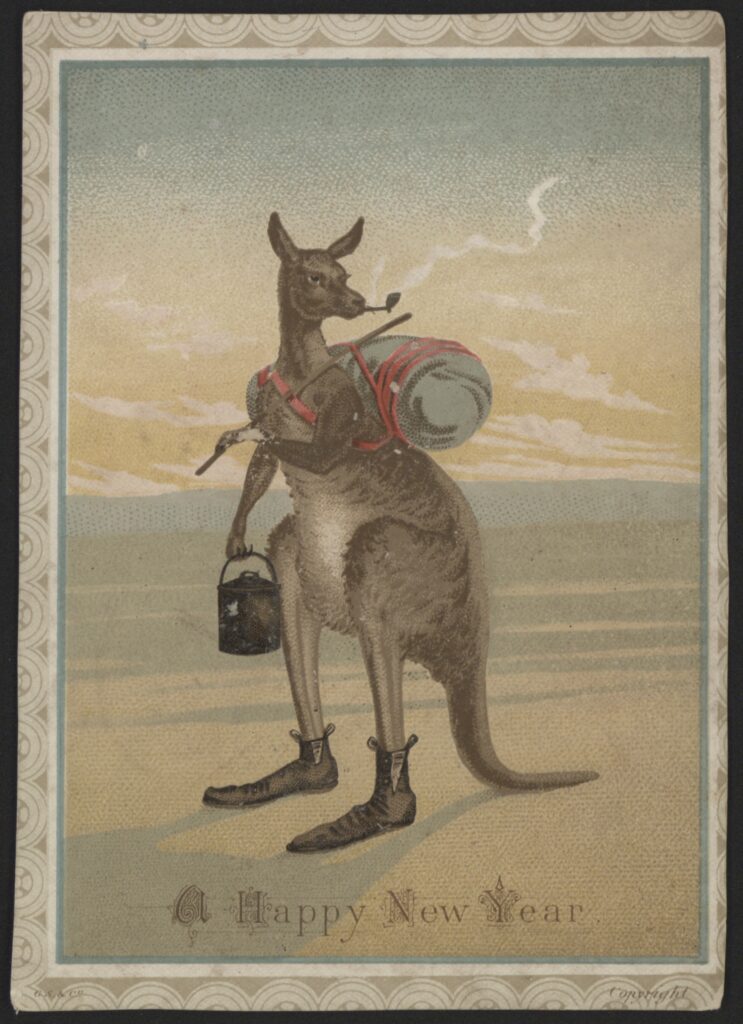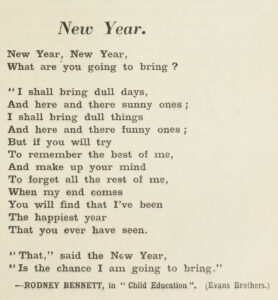
A greeting card wishing the recipient a happy new year and featuring an artwork of a kangaroo dressed as a swagman. Public Domain. View full attribution information.
Today is New Year’s Day, which means it is also Public Domain Day – the day that new material passes into the Public Domain. No matter what copyright term applies to the material – life of the author, the year the material was first made public or the year it was made – copyright expires at the end of the relevant calendar year, making 1 January an important date for more reasons than just ushering in the new year.
The Public Domain consists of all the books, music, visual art, films and other content not protected by copyright. While there is a thin sliver of material that never attracts copyright protection, the majority of the Public Domain is made up of material whose copyright term has expired. With a copyright term that is essentially two people’s lifetimes (i.e. life of the creator plus 70 years), naturally a lot of the Public Domain is old. But the Public Domain is not some dusty relic of the past. It is source material that anyone can share, use and adapt. It is at the heart of Australia’s identity, its legacy and its future.
Artists, students, educators, researchers, historians, documentarians, innovators and everyone else are freely able to draw on this rich body of cultural material, building on ideas, adding to knowledge, sparking new creativity with fresh takes and new perspectives. As Jennifer Jenkins at the Center for the Study of the Public Domain at Duke Law School said:
“Think of all of the works spawned by public domain stories and characters, whether it is Shakespeare’s plays, Jane Austen’s novels, Mary Shelley’s Frankenstein, or Bram Stoker’s Dracula. Shakespeare alone has inspired hundreds of new creations. 10 Things I Hate About You and Kiss Me Kate come from The Taming of the Shrew, West Side Story from Romeo and Juliet, Forbidden Planet from The Tempest.”
Protecting creativity is important, but ensuring we have a flourishing Public Domain is also crucial. Australia’s cultural and innovation landscape is enriched when we are free to build upon the ideas of the past. It is a legacy we inherit and to which we bequeath our own creativity. By standing on the shoulders of giants we draw from a vibrant and dynamic creative ecosystem outside of proprietary ownership.
It might sound cheesy to say the Public Domain is a treasure trove of creativity and innovation, but it really is. It is literally the reason why the much loved (and defended!) online database of Australian cultural heritage is called Trove.

A poem by Rodney Bennett for the 1952 new year. Public Domain. View full attribution information.
Worldwide, a vibrant and varied Public Domain faces challenges. The increasing complexity of copyright law and lobbying to further extend the duration of copyright minimises the Public Domain. It threatens to encircle and suffocate this vital body of content. To illustrate, here in Australia we changed the term for literary, dramatic, musical and artistic works to life of the author plus 70 years in 2005 as part of implementing the Australia-United States Free Trade Agreement (AUSFTA). We won’t see the majority of works enter the Public Domain again until 1 January 2026. While we wait, we should not stop our advocacy of and support for the Public Domain.
Even where material has moved into the Public Domain it can be difficult to find and access. Our libraries, archives, museums, galleries and cultural collections are fundamental to the Public Domain. They collect, care for and preserve so much of our shared heritage – during and after its copyright life. Digitisation of cultural heritage plays a significant role in the discoverability and usability of Public Domain material. We need to do more to make it easy for cultural collections to digitise their Public Domain treasures and make them accessible to Australians.
Importantly, the Public Domain is not merely a legal concept; it is a living repository of cultural heritage. By recognising the importance of the Public Domain and actively working to preserve it, Australia can ensure that its rich tapestry of stories, ideas, and creations continues to thrive and inspire future generations. In doing so, Australia celebrates not only its past but also invests in a creative and innovative future. This Public Domain Day we want to remind Australias that their Public Domain is a precious resource that needs protecting.
